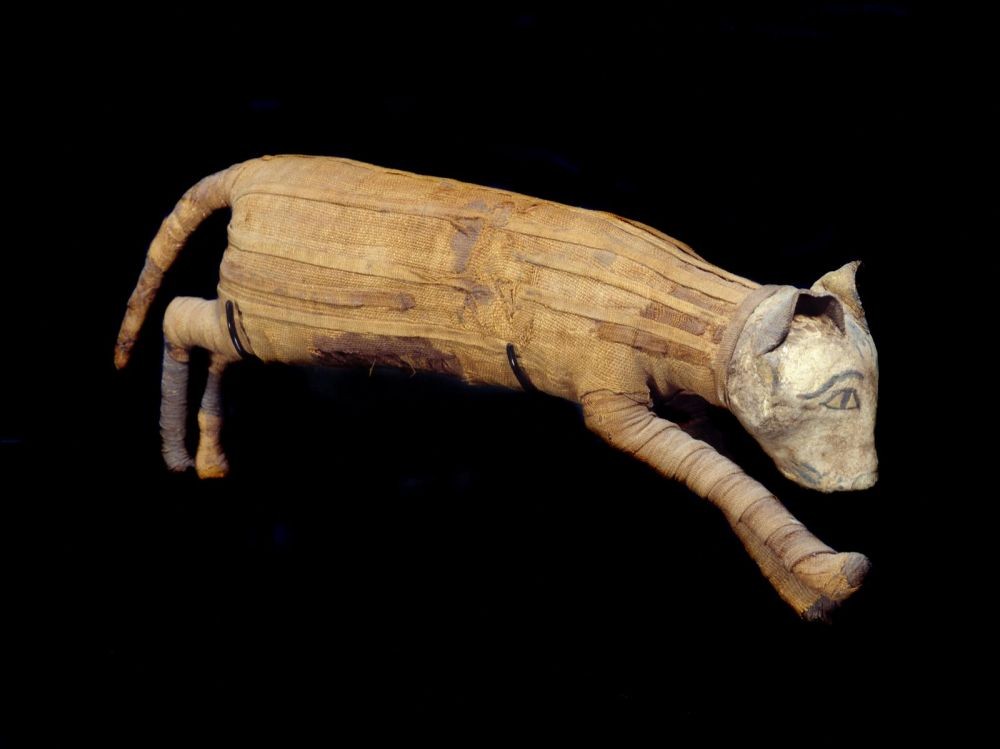Bulls, rams, crocodiles, cats, but also snakes, shrews and hawks... Few animal species escaped the hands of the embalmers of ancient Egypt.

Cat mummy from the Late Period (664-332 BC). Paris, Louvre Museum.
"The embalmed bodies of the Apis bulls in Memphis, Boukhis in Hermontis or even Mnevis in Heliopolis, just like the ram of Mendes or that of Elephantine, are true living gods, objects of worship" , lists Françoise Dunand, professor emeritus of the history of religions at Marc-Bloch University in Strasbourg. In Fayoum, the mummy of the crocodile god Sobek is venerated in several temples which raise sacred saurians for this purpose. In Thebes, also the place of worship of Sobek, a crocodile is trained, tamed, covered in earrings and bracelets and generously fed. Before being mummified.
For the Egyptians, certain species facilitate communication with deities
The Egyptians also consider that certain species facilitate communication with deities. They treat the former with great devotion in the hope of currying favor with the latter. This is the case of the cat with the goddess Bastet, of the ibis for the god Thoth, of the falcon for Horus. From then on, the temples dedicated to these gods received as offerings animals whose bodies were treated for eternity.
"The embalmed bodies of the Apis bulls in Memphis, Boukhis in Hermontis or even Mnevis in Heliopolis, just like the ram of Mendes or that of Elephantine, are true living gods, objects of worship" , lists Françoise Dunand, professor emeritus of the history of religions at Marc-Bloch University in Strasbourg. In Fayoum, the mummy of the crocodile god Sobek is venerated in several temples which raise sacred saurians for this purpose. In Thebes, also the place of worship of Sobek, a crocodile is trained, tamed, covered in earrings and bracelets and generously fed. Before being mummified.
For the Egyptians, certain species facilitate communication with deities
The Egyptians also consider that certain species facilitate communication with deities. They treat the former with great devotion in the hope of currying favor with the latter. This is the case of the cat with the goddess Bastet, of the ibis for the god Thoth, of the falcon for Horus. From then on, the temples dedicated to these gods received as offerings animals whose bodies were treated for eternity. This is how hundreds of thousands of mummified ibises have been found in Hermopolis, the center of the cult to Thoth, and thousands of cats in Bubastis where Bastet is prayed to. These temples operate bird and feline farms in order to meet the demand of pilgrims."You have to imagine sellers of ex-voto offering mummies at different prices, like these souvenir merchants that we meet today around the places of pilgrimage" , emphasizes Francis Janot. Archaeologists like Cardiff University's Paul Nicholson, a specialist in animal worship at Saqqara (he is known to have examined several thousand swaddled species), have found big differences in treatment, however. Some animals are just gutted and wrapped in bandages, while others are desiccated according to the rules and locked in wooden or stone sarcophagi. The sale of these religious objects will intensify throughout the first millennium before our era.
There are also birds, dogs, cats in more modest graves
Finally, and apart from any religious intention, Egyptians also maintain close and emotional relationships with their domestic animals. It is therefore not uncommon to find mummies in tombs. "In Memphis, archaeologists unearthed in the tomb of Prince Thutmose, eldest son of Amenhotep III, the limestone sarcophagus of his favorite cat" , reports Françoise Dunand. But there are also birds, dogs, cats in more modest graves. "One can only imagine that their owner wanted to keep them with him for eternity" , concludes the archaeologist.
This article is from the special issue of Sciences et Avenir "Egypt:the invention of eternity", published in April 2019.
